Changelog: Redesigned product page and other updates
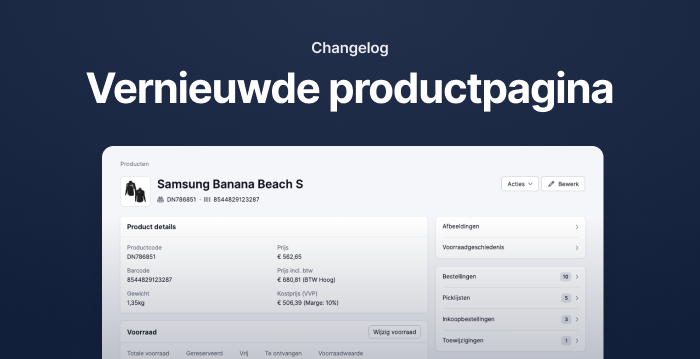
Redesigned product page
We’ve redesigned the product page. Information and actions that belong together are now grouped into cards, making the layout more structured and easier to scan. By using the available space more efficiently, you get a clearer overview of the product.
Just like with the updated pick list page, you can try out the new design via the experimental features page.
We’re curious to hear your feedback!
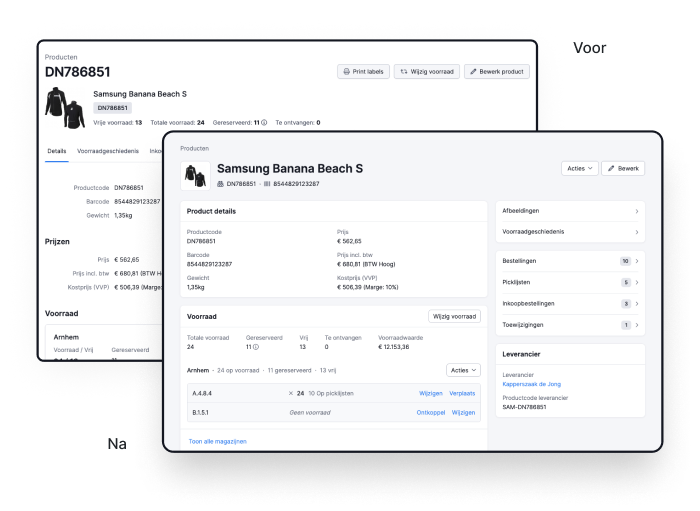
Automatic subscription adjustment
If your number of orders is increasing or decreasing, a different Picqer subscription might be more cost-effective for you.
Previously, you could manually switch plans when you expected a better deal. Now, we’ll automatically adjust your subscription retroactively if a different plan would have been cheaper in the past month. You’ll receive an email from us for each automatic adjustment, so you no longer have to worry about it.
Android app update
Version 2.4.0 of our Android app is now available. This update includes several changes that improve app stability. If you’ve been experiencing occasional crashes, we recommend updating to the latest version via the Google Play Store.
Other improvements
- You can now create a PrintNode account directly in Picqer. This makes it easier for users to get started with automatic printing.
- Fulfilment companies can now filter by fulfilment client on the returns page.
- When importing products using an Excel file, any country name entered (in the “Country of origin” column) is now converted to the ISO-3166-2 country code. This ensures integrations using this field continue to work properly.
- The Picqer app is now also compatible with the Honeywell ScanPal EDA5S. For full support of EAN13 barcodes, you need to adjust the settings of the scanner.
- We’ve added the new webhook
comments.created. This triggers when a new comment is added in Picqer. - You can now use product variables in the email template for shipping notifications. For example, you can include the total quantity or list the products and quantities in the message. Learn more about shipping notifications.
- In the app, you can now scan a location and link it to a product using the “Manage locations” option on the product page.
- If you use Shipping via Bol.com, there is now a setting to define which VVB orders should be snoozed. You can choose to snooze only if the consumer has selected a preferred delivery date. Be aware that this may result in orders without a preferred date being shipped too early. Bol.com may issue warnings for this. Read more about connecting Shipping via Bol.com.
Onboard new order pickers quickly with Picqer
It’s becoming increasingly difficult for webshops to find and retain warehouse staff. That’s why it’s important to be able to onboard new order pickers quickly so they can start contributing right away.
Picqer is built to make warehouse work as logical and simple as possible. The software guides users step by step, and the interface is designed to be clear and intuitive, using colors, alerts, and icons that anyone can understand. This allows anyone, with or without experience, to work independently in no time. In this article, we’ll explain how to use Picqer to onboard new order pickers in just a few minutes.
- We recommend using locations. When every location has its own number, Picqer can optimize the order of the pick list. The order picker can simply follow the list and doesn’t have to search for the right spot in the warehouse.
- If you're using barcodes, each product can be scanned. This makes it easier to pick products without requiring prior product knowledge.
- If you're using handheld scanners, order pickers can instantly check whether they’ve picked the correct product during both picking and packing.
Below, you’ll find an overview of the onboarding process for a new order picker, based on the setup described above. In this example, we use batch picking (multiple pick lists combined into one), since that involves the most steps. If you’re picking one list at a time, products are scanned only during the picking process. At the packing table, they can be packed immediately. Read more about the different picking methods here.
Ready to go with just one system
To start picking, simply open Picqer. There’s no need to log into other systems like your webshop, carrier, or stock system. Because everything is connected to Picqer, orders are imported automatically. Picqer checks whether the ordered products are in stock and creates a pick list—your to-do list for the day.
Picqer guides you to the right spot in the warehouse
You open the pick list on your handheld scanner (or print it, if you prefer). Picqer has already sorted the list to match your most efficient walking route. It tells you how many items to grab from each shelf and which container they should go into. You scan each product before placing it in the container, so you can be sure it’s the correct item.
A final check at the packing table
To complete the pick list, you scan each product one last time at the packing table. Picqer checks the order, and you double-check it visually. If anything’s off, you’ll get a message so you can make manual adjustments—for example, if an item is too heavy for standard shipping. Once everything checks out, Picqer prints the correct shipping label. You can pack the order and move on to the next pick list.
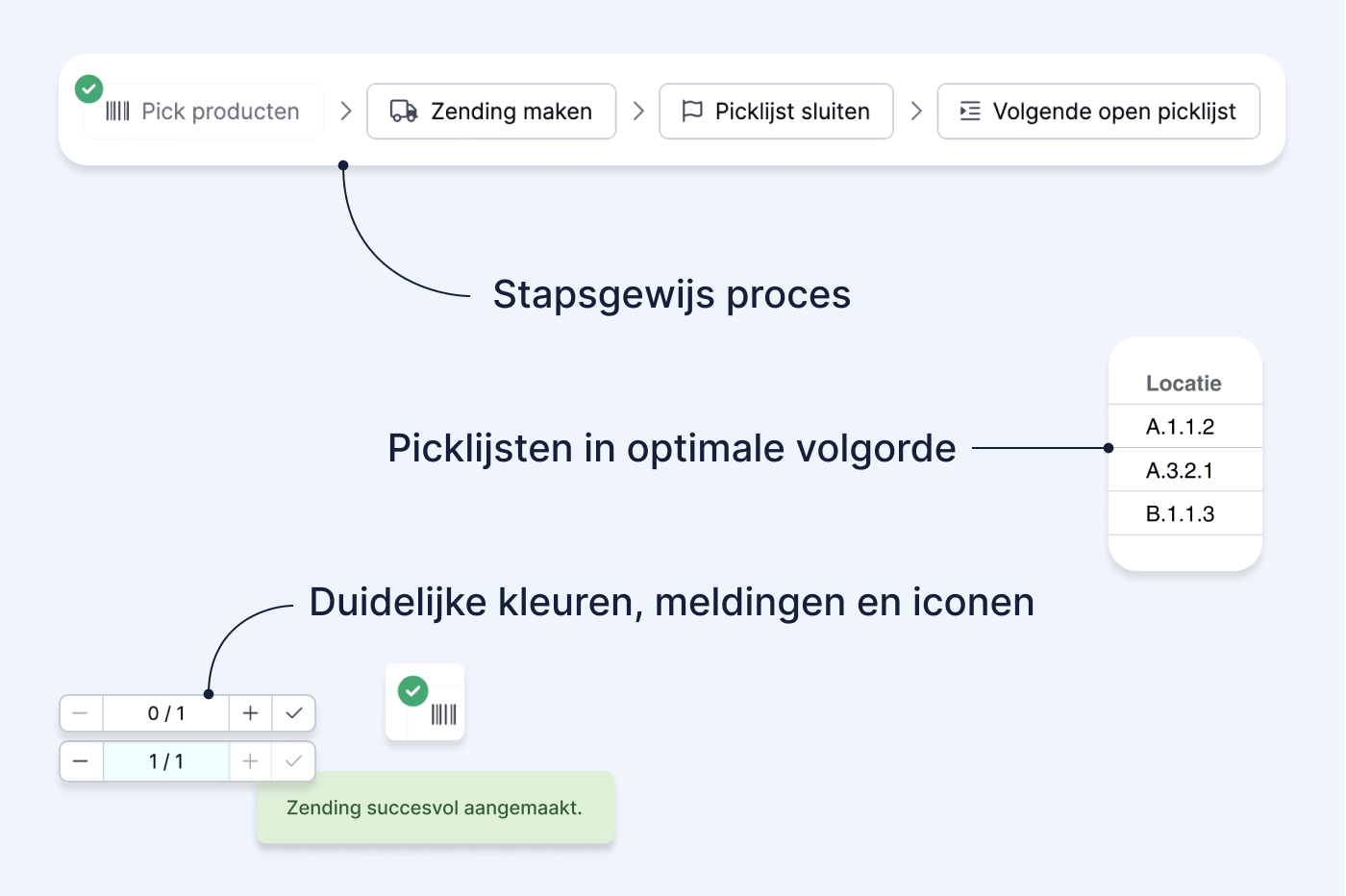
New: Containers
We’ve added something new to Picqer: Containers. With Containers, you can easily move stock within your warehouse while keeping your stock levels per location accurate at all times. We announced this feature at the Picqer Magazijnfestijn, and it’s now available to everyone.
What are Containers?
A container can be anything you use to move stock. For example, a shopping cart, a plastic bin, or a pallet. We refer to all of these as containers. Each container has a unique, sequential number and a barcode, making it easy to move stock into a container.
When you move stock from location 1 to location 2, it often takes a bit of time. Sometimes a minute, but sometimes several hours—especially when moving large quantities, like when using the refill advice.
With Containers, you first move the stock from location 1 to the container. Later, you move it from the container to location 2. This gives you visibility into which stock is in transit, and your per-location inventory remains accurate at all times.
In practice
In this video, I explain the entire concept:
Refill advice and beyond
We’re starting with Containers in the refill advice feature. You can also manually move stock into containers. Create your first container and try the refill advice with containers.
In the future, we’ll add Containers to returns, receipts, and more, so you’ll be able to handle all internal movements in your warehouse using Containers.
We’d love to hear how this works for you in practice—send your feedback to support@picqer.com.
Recap: Picqer Warehouse Fest 2023
Last week, we welcomed Picqer users to Nijmegen for the Picqer Warehouse Fest—the successor to our annual Meet & Grill. Visitors came together to learn more about warehouse optimization and connect with fellow webshop owners.
Watch the aftermovie here:
Presentations
Casper Bakker kicked off the day with a look back at the past year and shared updates on the latest developments in Picqer. One of the highlights was the announcement of the new “Containers” feature, which will be available to all users next week.
Next up was Nick van Klinken from Alleeninkt.nl, who shared lessons from his 10 years as an e-commerce entrepreneur. His biggest takeaway? Talk to other entrepreneurs. A great introduction to the breakout sessions, which focused on bringing webshops together.
Breakout sessions
During the breakout program, attendees chose their own activities. There was plenty of knowledge sharing at the round tables on staffing, purchasing, and fulfilment. New connections were made during the speed dating sessions, and there was lots of interest in Picqer’s new features at the demo booths.
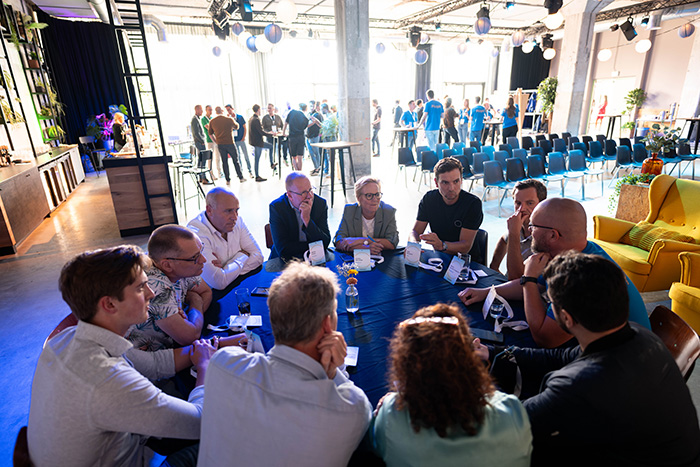
Networking drinks
We closed the day with live jazz music, drinks, and snacks at the networking reception. It was the perfect setting to exchange ideas and experiences.
It was a pleasure seeing everyone at the Picqer Warehouse Fest. We hope you made valuable new connections and left feeling inspired. See you next time!
Changelog: Comments in the app and other updates
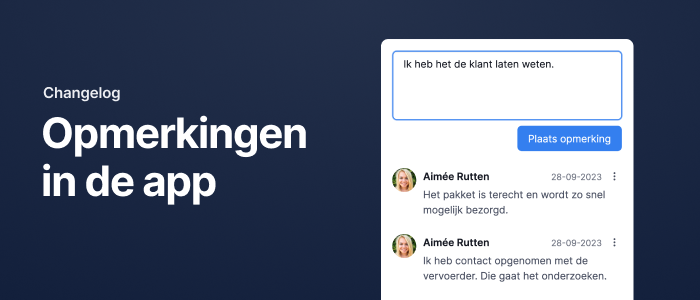
Comments in the app
In addition to comments on pick lists, you can now view and add comments in the app for products, purchase orders, and receipts.
From the Dashboard, you can access the full comment overview. Just like on desktop, you can view all comments, only your own, or only the ones where you’ve been mentioned.
Comments on batches
You can now add comments to batches in both the app and desktop. These comments are also shown on the PDF version of the batch.
Comments on pick lists and orders are now separate
Pick lists now have their own dedicated comments. Previously, comments from the order were shown on the pick lists. With this update, comments for pick lists and orders are now separated.
Any comment you place on a pick list is only visible on that specific pick list. It no longer appears on the related order or on other pick lists from the same order.
Control comment visibility for orders
You can now choose whether or not a comment on an order should appear on its pick lists.
This is helpful when certain notes are only relevant to customer service, and not to the order picker. Conversely, comments meant for the picker can be shown on the pick list to help them stay focused while processing.
Other improvements
- For a product, you can now set the replenishment level of the pick stock even when using the purchase strategy “Only buy for backorders.”
- The order log now shows when a pick list is unsnoozed.
- WooCommerce orders that initially contained no products were previously marked as “ignored.” These now get the status “ignore until updated,” allowing them to be imported later once products are added.
- Searching in the “Order statuses” overview in the fulfilment package has been significantly sped up.
- We’ve added a new integration with QLS.


